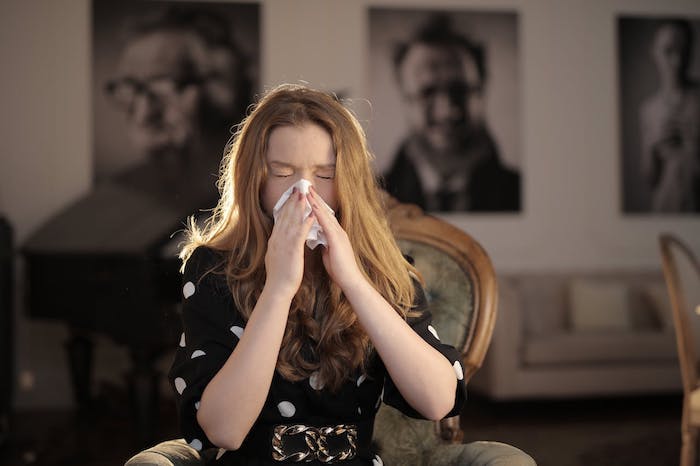
It’s red, inflamed, and ugly—how do you soothe a raw nose?
We’re in the middle of cold and flu season, which means many of us are dealing with this problem now or will be shortly.
You can try to cover it up with makeup, but meanwhile, we’ve got some tips to help you heal that irritated skin.
What Causes a Raw Nose?
When you blow your nose repeatedly, it usually results in a raw, sore, and red nose. Every time you use a tissue, you rub the skin of your nose. Over time, this causes that red, irritated look.
You may not realize you’re using tissues as often as you are. After all, there’s not much else you can do when your nose is running. But if you keep track, you may realize that you’re blowing and/or rubbing your nose with a tissue multiple times—sometimes a hundred times!—a day.
All that friction against your skin results in over-exfoliation. You’re rubbing the skin raw. You’re also disrupting the outer skin barrier, which can cause sensitivity and leave the skin vulnerable to bacteria invasion.
Your runny nose is likely damp, too. As it’s exposed to the air, the skin can become dry and chapped. If your cold continues for a week or more, you may even notice flaky skin or a scaly appearance.
It’s not just the cold and flu that leads to this problem. If you have allergies, you may deal with a raw, red nose year-round.
Talk about discouraging! The rest of your skin looks great, but there’s that red nose, ruining it all. What can you do?
How to Soothe a Raw Nose: 7 Tips
1. Pay Attention to Your Tissues
Some tissues are softer than others. It may be tempting to buy the cheap ones, but if you’re blowing your nose a lot, these will cause redness and irritation a lot faster than soft tissues that have lotion infused into them.
Some people use pre-moistened wipes instead, thinking they will be softer and cleaner than dry tissues. But this is usually a bad idea. They often contain fragrances, detergents, and other chemicals that can further irritate the skin—especially sensitive skin.
A moist wipe will also leave your skin damp—accelerating the development of dry, chapped skin. Stick to dry tissues that are soft and gentle.
2. Apply Moisturizing Balms
Just like you apply lotion after washing your hands (we hope!), you’ll want to apply a moisturizing, protective balm after blowing your nose. Every time, if you can, but as often as possible.
Blowing your nose has a stripping effect on your skin—it removes all the oils that keep it hydrated. Thus, you have to replace those oils and support the outer barrier. Choose a product that locks in moisture while taming inflammation and soothing irritated skin.
We recommend our Restorative Skin Balm to heal a raw, red nose fast. It includes healing ingredients like calendula, aloe vera, sea buckthorn oil, and arnica, which all help encourage skin regeneration. It also has carnauba and beeswax to safeguard the moisture barrier, while vitamin E aids in wound healing.
Castor oil, triglycerides, and glycerin all provide additional moisture, helping to counteract the damage done by tissues and blowing. You won’t find any clogging petrolatum ingredients—only a clean, fragrance-free solution that can help keep your nose looking healthy even while you battle that stubborn cold.
3. Use a Humidifier
A dry, red nose is a sign of moisture loss. During cold and flu season, the air is often cold and dry, too. It will steal moisture from your skin, exacerbating the dryness and resulting in chapped, flaky skin.
Unless you live in a very humid climate, it can help to use a humidifier, especially overnight. Place one in your bedroom, as it will pump moisture into the air, making it less likely that the air will steal from your skin. You’ll wake up to more moisturized, comfortable skin.
4. Watch for Infection
As long as you’re regularly applying our Restorative Skin Balm, your skin will stay clear and healthy. The product has natural anti-bacterial ingredients that will help fight off infection.
But if you’re not, watch for symptoms like cracking, pus, and a yellowish crust. These signal the presence of bacteria and inflammation. Gently clean the area and apply a topical antibiotic, or check with your doctor.
5. Consider Rinsing the Nasal Passages
Particularly if your runny nose is caused by allergies, a nasal rinse may help. You can try a spray saline rinse, which is simple to use and adds an antibacterial action, or use something like a neti pot morning and night. It will rinse allergens out of the nasal passages and could help you use fewer tissues.
If you are dealing with a lot of mucus, these solutions can also help, as they will rinse out the excess and could give you a break from blowing. Just be sure to always use distilled water. Never use tap as it could contain bacteria that could cause a sinus infection.
6. Be Cautious with Decongestant Sprays
Over-the-counter decongestant sprays can give you some relief from the stuffiness and blowing, but they may make the skin on the inside of your nose feel worse.
These medications work by constricting the blood vessels in the nose, which can cause discomfort. It’s also possible that you will adapt to these medications over time, after which your symptoms could get worse.
So use these only as a last resort and only for a limited time—no more than three days.
7. Sip Something Steamy
You may have heard that chicken soup can help reduce the duration of a cold. Scientists have found that it may contain several anti-inflammatory substances that ease the symptoms of upper respiratory tract infections.
A cup of eucalyptus tea can also help fight off the bacteria that cause a runny nose. But anything you consume that is hot and steamy is likely to help loosen up the nasal passages and relieve congestion.
How do you manage a raw, red nose?
Featured image courtesy of Andrea Piacquadio via Pexels.






